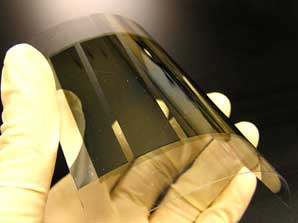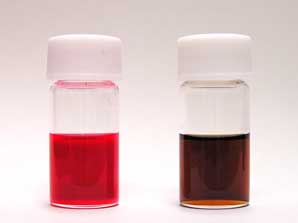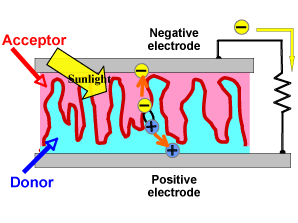Web Japan > Trends in Japan > Sci-tech > Toward a Solar Future
Toward a Solar Future
New Cells Could Herald Era of Solar Clothing and Paint
Solar cells are among the most promising power generation devices of the future. There are several kinds of solar cells, including silicon cells that use silicon as a substrate and dye-sensitized cells that use organic dyes. Now a Japanese research team has achieved success in the field of organic thin-film solar cells. Toray, a major chemical company, has achieved the world's highest conversion efficiency with an organic thin-film solar cell.
Solar Roofs and WallsThe research group of Professor Hashimoto Kazuhito of the University of Tokyo is working to develop organic thin-film solar cells that can be used like paint, taking advantage of self-organization, one of the properties used in nanotechnology. Self-organization is a phenomenon in which the molecules in a material form ordered structures autonomously. Using materials that have this characteristic makes it possible to make organic thin-film solar cells that can be applied in liquid form, like paint.
Professor Hashimoto and his team have developed a material whose molecules self-organize into an orderly arrangement with gaps of 20 nanometers. They have also achieved a conversion efficiency of 3% in organic thin-film solar cells that use this material. In the future, says Professor Hashimoto, it may be possible to apply this type of organic thin-film solar cell to the roofs and walls of a house so that, in effect, the entire house generates electricity.
How Organic Thin-film Solar Cells WorkIn thin-film solar cells, a thin layer consisting of two types of organic material is made between electrodes, and the electrons that flow from this layer generate electricity. The two materials that make up the thin film are a donor material, which releases electrons, and an acceptor material, which takes up these electrons and carries them to the negative electrode. Increasing the maximum voltage and maximum current generated by a solar cell improves the cell's conversion efficiency. The maximum voltage depends on the energy gap between the donor and acceptor materials, while the maximum current depends on the condition of the junction between the two materials.
By replacing part of the donor material skeleton with a new skeleton, Toray increased the energy gap from 0.6-0.7 volts to 1 volt. In addition, by joining two types of new substituent to the donor material, the junction between the two materials was improved. As a result the firm succeeded in raising the conversion efficiency from solar energy to electrical energy from the previous world best of 5.15% to 5.52%.
Among the various types of solar cells, development of the silicon type is the most advanced. Manufacturing silicon solar cells, however, is a complex and costly process. Moreover, the cells are rigid and unbendable, which restricts their range of applications. Organic thin-film solar cells, on the other hand, can be produced through processes similar to printing or ink-jet technology, which will enable costs to be reduced substantially when the cells are mass-produced. Moreover, since they are flexible and bendable, they have a vast array of potential applications, including as energy sources that people can wear on their bodies. On the downside, their conversion efficiency is currently lower than that of silicon cells. For organic thin-film solar cells to be viable, their efficiency will need to be raised to around 7%. Toray's progress is a big step toward this goal, and the company is aiming to commercialize the cells by 2015. (August 2009)
- Harnessing the Rising Sun (October 6, 2006)



